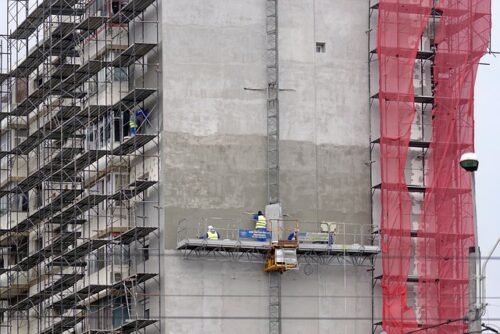Commercial real estate plays a significant role in shaping the built environment, but it also has a profound impact on global climate change. With increasing urbanization and a growing number of buildings to accommodate businesses, the real estate sector is one of the largest contributors to carbon emissions, energy consumption, and environmental degradation. This article explores the various ways commercial real estate contributes to climate change and discusses potential solutions to mitigate its effects.
Energy Consumption and Emissions
One of the most significant impacts of commercial real estate on climate change is its enormous energy consumption. Office buildings, shopping centers, warehouses, hotels, and other commercial properties require vast amounts of electricity, heating, cooling, and lighting to function. The real estate sector consumes over 40% of the world’s energy, with commercial properties making up a substantial portion of that consumption.
Buildings produce large amounts of greenhouse gases (GHG) primarily through their energy use, with electricity generation from fossil fuels being a major culprit. In particular, the burning of coal, oil, and natural gas for heating, cooling, and powering buildings contributes heavily to global carbon dioxide (CO₂) emissions. Commercial real estate is responsible for nearly 28% of total global carbon emissions, according to the International Energy Agency (IEA).

Construction and Resource Extraction
The construction of commercial buildings involves the extraction and use of significant natural resources such as timber, steel, and concrete. The production of these materials, especially concrete, is energy-intensive and contributes to high levels of CO₂ emissions. For example, the cement industry alone accounts for approximately 8% of global emissions, largely due to the chemical processes involved in its production.
Additionally, the construction process itself—powered by heavy machinery, transportation of materials, and waste generation—adds further to emissions. Site preparation, demolition of old buildings, and the land-use changes associated with commercial development can also disrupt ecosystems, leading to the loss of biodiversity and the release of carbon stored in vegetation and soils.
Urban Heat Islands
The concentration of commercial buildings in cities leads to the formation of urban heat islands (UHI), where urban areas experience higher temperatures than their rural surroundings. This is primarily due to the extensive use of concrete, asphalt, and other heat-absorbing materials, as well as the reduced green spaces in cities. Higher temperatures in urban areas increase the demand for air conditioning and energy, which in turn leads to more greenhouse gas emissions.
Urban heat islands also exacerbate the effects of heatwaves, making cities more vulnerable to climate change. Commercial buildings, by virtue of their large presence in urban centers, are a key contributor to this phenomenon.
Water Usage and Waste Generation
Commercial buildings use large amounts of water for daily operations, landscaping, and cooling systems, putting pressure on local water resources. In some regions, especially areas prone to drought, the high demand for water by commercial real estate can contribute to water scarcity and have a knock-on effect on the environment.
Furthermore, commercial properties generate significant amounts of waste, including construction debris, office waste, and food waste from restaurants and cafeterias. Much of this waste ends up in landfills, where it decomposes and releases methane, a potent greenhouse gas.
Sustainable Solutions and Green Buildings
To mitigate the impact of commercial real estate on climate change, there has been a growing focus on sustainable building practices and energy efficiency. The development of green buildings—those designed to minimize environmental impact through energy-efficient materials, renewable energy systems, and resource conservation—has gained momentum. Certifications like LEED (Leadership in Energy and Environmental Design) and BREEAM (Building Research Establishment Environmental Assessment Method) set standards for sustainable commercial buildings, encouraging developers to focus on reducing energy consumption, lowering emissions, and improving water efficiency.
One promising solution is the use of renewable energy in commercial properties, such as solar panels and wind turbines. By integrating renewable energy sources into their power systems, buildings can significantly reduce their carbon footprint and reliance on fossil fuels. Additionally, innovations in energy-efficient technologies, such as smart thermostats, LED lighting, and advanced insulation, can lower energy consumption and operational costs.
Another key strategy is retrofitting older commercial buildings with modern, energy-efficient technologies. Since many commercial properties are decades old, retrofitting them to improve insulation, HVAC systems, and lighting can make a significant difference in reducing emissions.
The Role of Governments and Regulation
Governments play a crucial role in regulating the commercial real estate sector’s environmental impact. By enforcing stricter building codes and promoting energy efficiency standards, they can drive the adoption of sustainable practices. Many cities have introduced carbon-reduction targets for new developments, offering incentives such as tax breaks and subsidies to encourage the construction of energy-efficient buildings.
For example, cities like New York and London have introduced ambitious plans to make their building stock carbon-neutral by 2050. These initiatives focus on reducing emissions in both new and existing commercial buildings and promoting the use of renewable energy sources.
Future Trends and Outlook
The future of commercial real estate will likely see even more emphasis on sustainability as climate change becomes an increasingly urgent global issue. Innovations such as net-zero buildings—which produce as much energy as they consume—are gaining traction, while circular economy principles are being applied to reduce waste and make more efficient use of materials.
As more businesses recognize the financial benefits of sustainability, there will likely be a shift toward green leases, where tenants and property owners collaborate to improve energy efficiency and reduce operational costs. Investors are also driving demand for sustainable real estate, as environmental, social, and governance (ESG) factors become a priority in investment decision-making.
In Summary
Commercial real estate has a substantial impact on global climate change due to its energy consumption, resource use, and emissions. However, with the rise of sustainable building practices, renewable energy integration, and more stringent regulations, the industry has the potential to reduce its environmental footprint significantly. The path forward lies in adopting innovative solutions, retrofitting older buildings, and prioritizing sustainability in new developments, ensuring that the commercial real estate sector contributes to a more sustainable and climate-resilient future.
Green Improvement Property Programs: The Green and Resilient Retrofit Program (GRRP)
Using CPACE for Commercial Property Improvement: The Green and Resilient Retrofit Program (GRRP)
Use a Trinity Street Capital Partners Bridge Loan, to make Green Improvements to your property.

